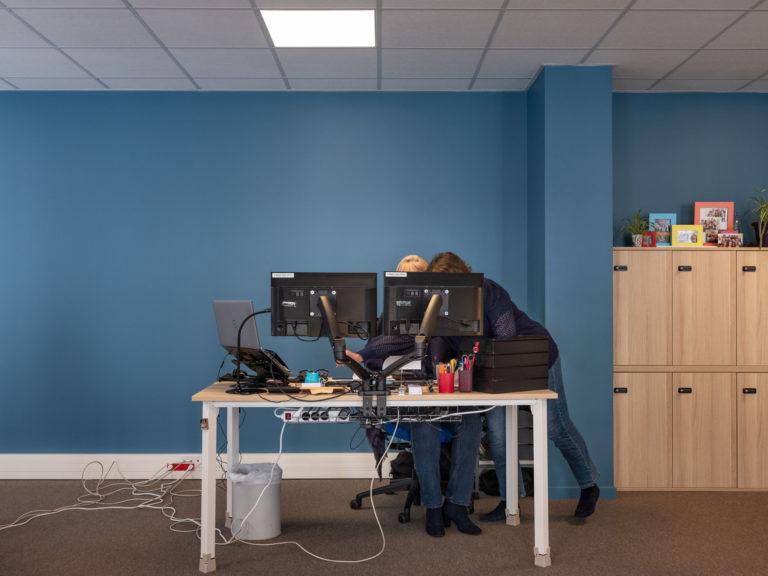It rains, Paris, 1st July 2000
2004 - Photography (Photography)
57 x 75 cm
Jean-Luc Moulène
It rains, Paris, 1st July 2000 , which could be the refrain of a song, is the title of a photograph of a minimal moment, the vision of a Parisian pedestrian, a cut flower lying on the pavement covered in rain drops. Is this moment captured by chance or a mise en scène? There is a sort of hiatus in the image; the planes – motif and background – connect nature in full bloom, pure, fragile, ephemeral with the grey weighty tarmac. The calm of the raindrops in It rains, Paris, 1st July 2000 contrasts with the gushing in La Fontaine des Amoureux, Paris, 3 avril 2006 . Contrary to Nœud coulant (also in the Kadist collection) that opens up possibilities for thought and research, the elements of this photograph are organized like a rhizome. The raindrops and the flower petals form a network of points which the spectator can mentally link and recompose. On one hand tightly knit, dispersed on the other. The motif tends to fuse with the background to create one unique plane. The image generally tends towards a certain flatness, rather like medieval tapestries in the Mille fleurs style or in fabrics with flowery prints. In the recent “Fleurs” series (2008), the artist photographed wild flowers, placing them in front of colored backgrounds that extract them from their natural pastoral setting.
After training in literature and working in advertising, Jean-Luc Moulène became known in the 1990s for his ‘documentary’ photographic practice. His images could be considered as studies of natural and cultural phenomena; the Objets de grève ( Strike objects) series (1999) documents objects made in factories during social protests. Moulène uses the codes of media images and diverts them to liberate the gaze and produce a new imaginary. This poetic tactic is manifest in the series called Disjonctions , in which Moulène photographs still lives, portraits, daily urban scenes. The notion of disjunction, which can be interpreted in the grammatical sense (‘or’, ‘either… either…’) or in terms of logic (an alternative in a dilemma), is manifest in the image by the disunity of the elements in the composition. The artist is not just a photographer, he increasingly creates relations with drawing, sculpture, objects, texts and newspapers.
Colors:
Other related works, blended automatically
» see more
Related works sharing similar palette
» see more

© » EYE OF PHOTOGRAPHY
© 2023 All rights reserved - The Eye of Photography Olivier Culmann, URSSAF Normandie, site du Havre @ Olivier Culmann Le Havre, Seine-Maritime, Normandie, France 10/05/2023 © Olivier Culmann / Tendance Floue @ Thomas Jorion @ Sidonie Van Den @ Isabelle Scotta @ Carlo Lombardi S From October 21st to January 7th, 2024, for its 14th edition, 25 international photographers, both established and emerging, can be discovered in an open-air exhibition tour throughout the city, on the beach, and indoors at Point de Vue and Les Franciscaines...

© » KADIST
Arash Fayez
2021The short film I Can Only Dance to One Song by Arash Fayez features a series of people from the migrant community in Barcelona singing along or dancing to songs of their choosing...

© » KADIST
Amapola Prada
2013n the opening scene of the video Power (La Fuerza) we see a mature woman asleep in a dark room...
Other works by: » Jean-Luc Moulène
» see more

© » KADIST
Jean-Luc Moulène
1997On a piece of paper, the artist has traced two loops in black crayon and placed two eyes where the lines intersect...

© » KADIST
Jean-Luc Moulène
2009Head Box by J ean-Luc Moulène i s not the representation of a space but a real space that remains in the domain of sculpture which the artist develops in parallel with his photographic practice...
Related artist(s) to: Jean-Luc Moulène » Florian Hecker, » Harun Farocki, » Lara Almarcegui, » Seulgi Lee, » Adel Abdessemed, » Akram Zaatari, » Allen Ruppersberg, » Amos Gitai, » Anri Sala, » Carol Rama
» see more

© » KADIST
Seulgi Lee
2018The Korean title for U: Repair the cowshed after losing the cow = Too late is —a famous Korean proverb meaning “you are doing something when you are already late to do it”...

© » KADIST
Allen Ruppersberg
1970Untitled (City Limits) is a series of five black-and-white photographs of road signs, specifically the signs demarcating city limits of several small towns in California...
Related works found in the same semantic group
» see more

© » KADIST
Vivian Suter
Vivian Suter paints her canvases and then allows them to come in contact with natural elements...

© » LENS CULTURE
Gilded Lilies - Photographs by Tine Poppe | Interview by Sophie Wright | LensCulture Feature Gilded Lilies Norwegian photographer Tine Poppe’s portraits of cut flowers, shot against landscapes ravaged by climate change, propose a new take on the still life—one fit for the uncertain times we are living in...

© » KADIST
Yto Barrada
2007This photograph is part of the series titled “Iris Tingitana project” (2007) focusing on the disappearance of the iris...





